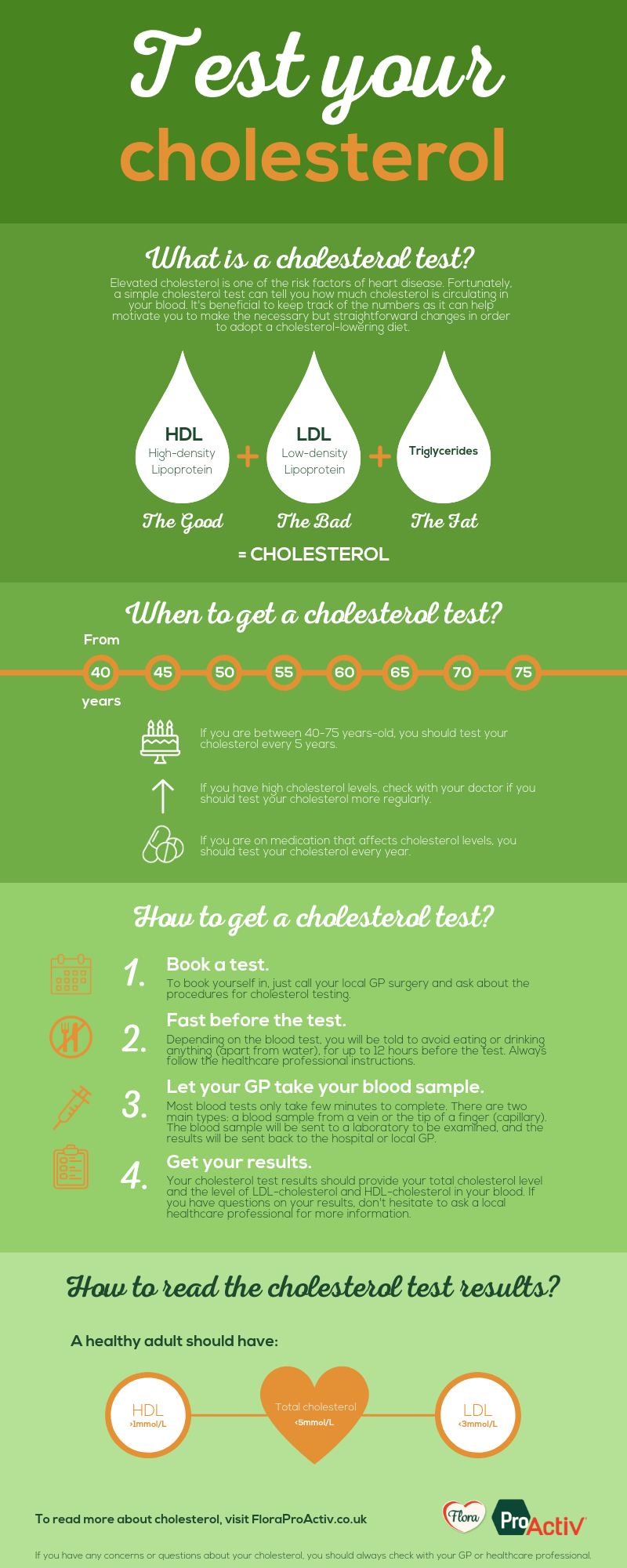Click here to see the infographic.
By pumping blood around the body, your heart takes good care of you – and there are plenty of different ways to look after it in return. Exercise and a balanced diet are usually advised, as they are essential for a healthy heart, but there’s another simple thing we can do to give our hearts a helping hand: a cholesterol test.
What does this mean? It’s about being aware of important health statistics, such as Body Mass Index (BMI), blood pressure, and – as we will explain below – cholesterol levels. To help out, we’ve put together a handy guide explaining the ins and outs of a cholesterol test.

Why get a cholesterol test?
Elevated cholesterol is one of the risk factors of heart disease. Fortunately, cholesterol levels are incredibly straightforward to check! A simple cholesterol test can tell you how much cholesterol you have circulating in your blood. This information is very useful, and can help motivate you to make the simple but necessary changes for adopting a healthy balanced diet when needed.
How is a cholesterol test booked?
It shouldn’t be too hard for anyone who wants to get their cholesterol tested to do so. Checks by qualified healthcare professionals are free and easily available on the NHS. To book yourself in, just call your local GP surgery and ask about their procedures for cholesterol testing. A few things to keep in mind:
- Many GPs will have nurse-led clinics which can do a comprehensive health check, and then offer support and advice depending on the results.
- Some pharmacies also provide this service; ask in store for advice on booking yourself in.
- Some local health services can actively invite people to come in for cholesterol testing.
- If you are over 40, doctors will probably want to check your cholesterol every five years, while for those on cholesterol-lowering drugs or with a family history of high cholesterol, it’s likely to be more often.
Understanding cholesterol results: how is cholesterol measured?
There are two main types of cholesterol tests: one which takes a blood sample from a vein, and one which takes it from a capillary – the smaller blood vessels found all over your body.
Blood sample from a vein. In this case, a healthcare professional will find a vein, usually in your arm or hand, and use a syringe to take a small vial of blood. This is then sent to a laboratory for analysis. While timelines vary, most practices will receive the cholesterol blood results in 48 hours and advise patients to ring up to get their results.
Blood sample from the tip or a finger (capillary). Here, a healthcare professional will use a small pinprick device to draw just a single drop of blood from the tip of a finger. They will then drip it onto a small strip which is inserted into a special device. This gives the results instantly, meaning you will find out your cholesterol blood results in minutes rather than days.
What happens once you get the cholesterol test results? Your healthcare professional will talk through the numbers to explain what they mean for your health. It’s important that you know not just the important statistics, but what they really indicate.
If the numbers are not in the target range, you will usually be given lots of helpful advice about lifestyle changes that you can make. So, by understanding cholesterol readings, you can make positive changes to your diet or exercise routine for a healthier lifestyle.
Reading cholesterol results: what do cholesterol blood test results mean?
Your cholesterol results should provide your total cholesterol level and the level of LDL-cholesterol and HDL-cholesterol in your blood. According to the NHS and Heart UK:
- Total cholesterol should be 5mmol/L or less for healthy adults, and 4mmol/L or less for those considered to be at ‘high risk’.
- Non-HDL-cholesterol should be 4 mmol/L or less.
- LDL-cholesterol should be 3mmol/L or less for healthy adults, and 2mmol/L or less for those at high risk.
- HDL-cholesterol should be at 1mmol/L.
- The lower your cholesterol ratio (total cholesterol divided by HDL cholesterol) is, the better – it should ideally be below four-to-one, according to the NHS, while Heart UK explains that a cholesterol ratio of above 6 is considered ‘high risk’.
The Flora ProActiv site has plenty of resources to help you understand cholesterol better. Here, you can find out what cholesterol is, or learn more about LDL-cholesterol and HDL-cholesterol in this guide. Finally, if you would like to lower your cholesterol, download our Cholesterol Lowering Starter Kit, and start lowering it today!
This information has been included in good faith, but is for general informational purposes only, and should not be construed as a guarantee. The nutritional facts and statements on this site are designed for educational and resource purpose sonly, not being substitutes for professional advice. If you have any concerns or questions about your health, you should always check with your GP or healthcare professional.

